#ortohodxy
Explore tagged Tumblr posts
Text
Saints&Reading: Sat., May, 15, 2021
Saint Athanasius the Great, Archbishop of Alexandria (373)
May 2/May 15

Saint Athanase the Great, Archbishop of Alexandria, was a great father of the Church and a pillar of Orthodoxy. He was born in about the year 297 in the city of Alexandria into a family of pious Christians. He received a fine secular education, but still more he acquired profound knowledge by diligent study of the Holy Scripture. From his childhood years the future great hierarch Athanase became known to the Alexandrian Patriarch, Saint Alexander (Comm. 29 May), through the following circumstances. One time a group of children, among whom was the lad Athanase, was playing at the shore of the sea. The Christian children decided to baptise their pagan playmates. The lad Athanase, whom the children chose as "bishop", performed the baptism, precisely repeating the words, heard by him in church during this sacrament. Patriarch Alexander observed all this from a window. He then commanded that there be brought him the children and their parents, and having conversed with them for a long while, and having attested that the baptism performed by the children at play was in everything in accord with the Church ustav (rule), he acknowledged the Baptism as real and supplemented it with the sacrament of Chrismation. From this moment the Patriarch looked after the spiritual upbringing of the youth Athanase and in time brought him into the clergy, at first as a reader, and then he ordained him to the dignity of deacon.
It was in this dignity of deacon that Saint Athanase accompanied Patriarch Alexander in the year 325 to the First OEcumenical Council at Nicea. At the Council, Saint Athanase stepped forth with a refutation of the heresy of Arius. This speech met with the approval of the Orthodox fathers of the Council, but the Arians – those openly so and those concealed – came to hate Athanase and subjected him to persecutions for all the rest of his life. After the death of holy Patriarch Alexander, Saint Athanase was unanimously chosen his successor to the Alexandria cathedra-seat. He long refused, accounting himself unworthy, but at the insistence of all the Orthodox populace that it was in agreement, at age 28 he was ordained to the dignity of bishop and put at the head of the Alexandrian Church. For 47 years Saint Athanase guided the Church, and during this time he suffered much persecution and grief from his antagonists. Several times he was expelled from Alexandria and hid himself from the Arians in desolate places, since they repeatedly tried to kill him. Saint Athanase spent more than 20 years in his exiles, and returned then to his flock, and then again was subjected to banishment. There was a moment in time when he remained as the only Orthodox bishop, a moment when all the other bishops had deviated into heresy. At the false-councils of Arian bishops he was declared deprived of the bishop's dignity. Despite the persecution of many years, the saint continued firmly to defend the purity of the Orthodox faith, and he wrote incessantly both missives and tracts against the Arian heresy. When Julian the Apostate (361-363) began a persecution against Christians, his wrath then first fell upon Saint Athanase, whom he considered the great pillar of Orthodoxy. Julian intended to kill the saint so as to strike Christianity a grievous blow, but he himself soon perished infamously. Mortally wounded by an arrow during the time of a battle, he cried out with despair: "Thou art victorious, Galilean". After the death of Julian, Saint Athanase guided the Alexandrian Church for seven years and died in 373, at age 76. Numerous works of Saint Athanasias have been preserved: four "Orations", directed against the Arian heresy; likewise an Epistle to Epictetos, bishop of the Church of Corinth, about the Divine and Human natures in Jesus Christ; four Epistles to Serapion, bishop of Thmuis, about the Divine Holy Spirit and Its Equality with the Father and the Son – directed against the heresy of Macedonias. There have been preserved also other works of apologetical character in defense of Orthodoxy, among which is the Letter to the emperor Constantius. Commentaries of Saint Athanase on Holy Scripture are known of, and also books of a moral didactic character, as well as a detailed biography of the Monk Anthony the Great (Comm. 17 January), with whom Saint Athanase was very close. Saint John Chrysostom advised every Orthodox Christian to read this life. The memory of Saint Athanase is celebrated also on 18 January conjointly with the memory of Saint Cyril of Alexandria.
© 1996-2001 by translator Fr. S. Janos.
The Holy Nobleborn Equal-to-the-Apostles Tsar Boris, in Holy Baptism Michael (907)
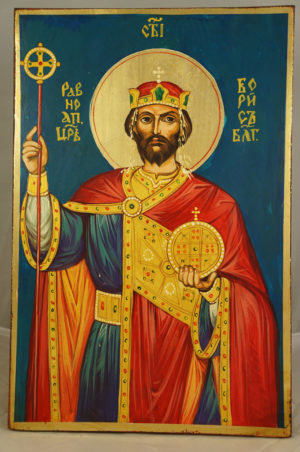
The Holy Nobleborn Equal-to-the-Apostles Tsar Boris, in Holy Baptism Michael: His Equal-to-the-Apostles exploits were foretold him by an uncle, Saint Boyan. The first years of the reign of tsar Boris unfolded with misfortune. The Bulgarians happened frequently to be at war with surrounding nations, famine and plague beset the land, and in the year 860 Bulgaria found itself in dire straits. Tsar Boris saw the salvation of his land, which dwelt in paganism, in its enlightenment by the faith in Christ. During the time of one of the battles of the Bulgarians with the Greeks he took captive the illustrious courtier Theodore Kuphares, who earlier had taken monastic vows. He was the first man planting the seed of the Gospel in the soul of the Bulgarian tsar. In one of the campaigns with the Greeks the young sister of tsar Boris was taken captive and raised at the court of the Byzantine emperor in the Orthodox faith. When the emperor Theophilos died, tsar Boris decided to take advantage of the favourable circumstance so as to take revenge upon the Greeks for his former defeats. But the widow of the emperor, Theodora, showed courage and sent a messenger to the Bulgarian tsar with the suggestion, that she herself was prepared to defend the empire and humiliate its opponents. Tsar Boris chose to have a peace alliance, and in sign of conciliation exchange was made of the captives Theodore Kuphares for the Bulgarian princess, who all the more swayed her brother towards the Christian faith. A while later there was sent into Bulgaria Saint Methodios, who together with his brother Saint Cyril was enlightening the Slavic peoples with the light of faith in Christ. Saint Methodios baptised tsar Boris, his family and many of the boyar-nobles. The pagan Bulgarians, having learned of this, wanted to kill tsar Boris, but their plot was frustrated by the tsar, and deprived of their rebellious leaders, the Bulgarian people voluntarily accepted Baptism. Between Byzantium and Bulgaria was concluded a peace, based on an oneness of faith, which was not broken until the end of the reign of the noble tsar. The Greek Patriarch Photios took great interest in the spiritual confirmation of the Bulgarian nation. In 867 preachers from the Roman pope were sent into Bulgaria, from which time over the course of three years discord prevailed in Bulgaria between the Greek and Roman Churches. A Council at Constantinople in 869 put an end to the quarrel, and on 3 March 870 Bulgaria was definitively conjoined to the Eastern Church, and Orthodoxy in it was affirmed even more. In Bulgaria were glorified the holy ascetics: Saints Gorazd (Comm. 27 July) and Clement of Okhrid (Comm. 27 July). Nobleborn tsar Boris adorned the land with churches and furthered the spread of piety, and afterwards in Bulgaria was established a Patriarchal cathedra-seat. In his declining years, holy tsar Boris withdrew to a monastery, leaving the throne to his sons Vladimir and Simeon. While in the monastery the saint learned that Vladimir, who succeeded to reign after him, had started on a path of renunciation from Christianity. Distressed by this, Saint Boris again donned his garb as tsar, punished his disobedient son and placed him in prison. Having entrusted the rule to his younger son Simeon, Saint Boris returned to the monastery. But he came out from it once more for the repelling of an invasion of the Vengrians/Hungarians. Holy tsar Boris, in holy Baptism named Michael, – reposed on 2 May 907.
© 1996-2001 by translator Fr. S. Janos.

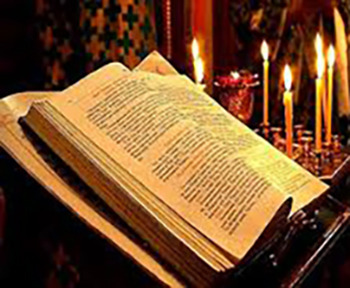
John 6:14-27
14 Then those men, when they had seen the sign that Jesus did, said, "This is truly the Prophet who is to come into the world." 15 Therefore when Jesus perceived that they were about to come and take Him by force to make Him king, He departed again to the mountain by Himself alone. 16 Now when evening came, His disciples went down to the sea, 17 got into the boat, and went over the sea toward Capernaum. And it was already dark, and Jesus had not come to them. 18 Then the sea arose because a great wind was blowing. 19 So when they had rowed about three or four miles, they saw Jesus walking on the sea and drawing near the boat; and they were afraid. 20 But He said to them, "It is I; do not be afraid." 21 Then they willingly received Him into the boat, and immediately the boat was at the land where they were going. 22 On the following day, when the people who were standing on the other side of the sea saw that there was no other boat there, except that one which His disciples had entered, and that Jesus had not entered the boat with His disciples, but His disciples had gone away alone. 23 however, other boats came from Tiberias, near the place where they ate bread after the Lord had given thanks- 24 when the people therefore saw that Jesus was not there, nor His disciples, they also got into boats and came to Capernaum, seeking Jesus. 25 And when they found Him on the other side of the sea, they said to Him, "Rabbi, when did You come here?" 26 Jesus answered them and said, "Most assuredly, I say to you, you seek Me, not because you saw the signs, but because you ate of the loaves and were filled. 27 Do not labor for the food which perishes, but for the food which endures to everlasting life, which the Son of Man will give you, because God the Father has set His seal on Him.
Acts 5:21-33
21And when they heard that, they entered the temple early in the morning and taught. But the high priest and those with him came and called the council together, with all the elders of the children of Israel, and sent to the prison to have them brought.22 But when the officers came and did not find them in the prison, they returned and reported, 23 saying, "Indeed we found the prison shut securely, and the guards standing outside before the doors; but when we opened them, we found no one inside!" 24 Now when the high priest, the captain of the temple, and the chief priests heard these things, they wondered what the outcome would be. 25 So one came and told them, saying, "Look, the men whom you put in prison are standing in the temple and teaching the people!" 26 Then the captain went with the officers and brought them without violence, for they feared the people, lest they should be stoned. 27 And when they had brought them, they set them before the council. And the high priest asked them, 28 saying, "Did we not strictly command you not to teach in this name? And look, you have filled Jerusalem with your doctrine, and intend to bring this Man's blood on us!" 29 But Peter and the other apostles answered and said: "We ought to obey God rather than men. 30The God of our fathers raised up Jesus whom you murdered by hanging on a tree. 31 Him God has exalted to His right hand to be Prince and Savior, to give repentance to Israel and forgiveness of sins. 32 And we are His witnesses to these things, and so also is the Holy Spirit whom God has given to those who obey Him. 33 When they heard this, they were furious and plotted to kill them.
2 notes
·
View notes
Text
Saints&Reading: Wed., Jan. 27, 2021
Commemorated on January 14_by the New calendar
The Monastic Fathers, Murdered at Sinai and Raipha
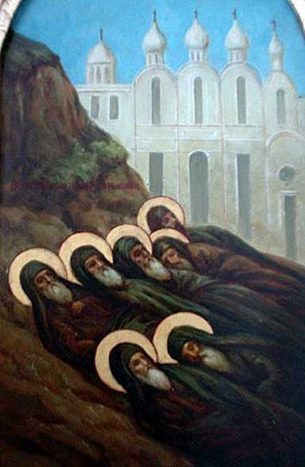
The Monastic Fathers, Murdered at Sinai and Raipha, asceticised at the monasteries and caves of Mount Sinai, where previously the Ten Commandments had been given through Moses; near to it also was the Raipha monastic wilderness (on the shores of the Red Sea). They suffered under the Saracens and under nomadic brigands from among the Arab tribes. The first massacre occurred in about the year 312. It was recorded by Ammon, an Egyptian monk, who witnessed the murder of the 40 holy fathers in Sinai. During this time the Arabs also killed 39 fathers at Raipha. The second period of the massacres occurred nearly an hundred years later, and was likewise recorded by an eye-witness who himself in the process miraculously escaped – the Monk Nilos the Faster (Comm. 12 November). The Sinai and Raipha ascetics lived a particularly strict lifestyle: they spent the whole week in their cells at prayer, on Saturday they gathered for the all-night vigil, and on Sunday they communed the Holy Mysteries. Their only food was dates and water. Many of the wilderness ascetics were glorified by wonderworking – the elders Moses, Joseph and others. By name, remembered in the service to these monastic fathers are commemorated: Isaiah, Sava, Moses and his student Moses, Jeremiah, Paul, Adam, Sergios, Domnos, Proklos, Ipatios, Isaac, Makarios, Mark, Benjamin, Eusebios and Elias.
© 1996-2001 by translator Fr. S. Janos.

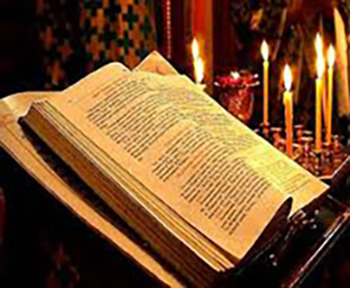
Matthew 10:1-8
1And when He had called His twelve disciples to Him, He gave them power over unclean spirits, to cast them out, and to heal all kinds of sickness and all kinds of disease. 2 Now the names of the twelve apostles are these: first, Simon, who is called Peter, and Andrew his brother; James the son of Zebedee, and John his brother; 3 Philip and Bartholomew; Thomas and Matthew the tax collector; James the son of Alphaeus, and Lebbaeus, whose surname was Thaddaeus;4 Simon the Cananite, and Judas Iscariot, who also betrayed Him. 5These twelve Jesus sent out and commanded them, saying: "Do not go into the way of the Gentiles, and do not enter a city of the Samaritans. 6 But go rather to the lost sheep of the house of Israel. 7 And as you go, preach, saying, 'The kingdom of heaven is at hand.' 8Heal the sick, cleanse the lepers, raise the dead, cast out demons. Freely you have received, freely give.
1 Corinthians 4:9-16
9For I think that God has displayed us, the apostles, last, as men condemned to death; for we have been made a spectacle to the world, both to angels and to men.10 We are fools for Christ's sake, but you are wise in Christ! We are weak, but you are strong! You are distinguished, but we are dishonored!11 To the present hour we both hunger and thirst, and we are poorly clothed, and beaten, and homeless.12 And we labor, working with our own hands. Being reviled, we bless; being persecuted, we endure; 13 being defamed, we entreat. We have been made as the filth of the world, the offscouring of all things until now. 14 I do not write these things to shame you, but as my beloved children I warn you. 15 For though you might have ten thousand instructors in Christ, yet you do not have many fathers; for in Christ Jesus I have begotten you through the gospel. 16 Therefore I urge you, imitate me.
#ortohodxy#orthodoxchristianity#ancientchristianity#originofchristianity#spirituality#holyscripture#gospel#sacred texts#wisdom
3 notes
·
View notes
Text
Icon, Saint&Reading: Wed., Oct. 7, 2020
Commemorated on September 24_according to the Julian calendar
The Holy First-Martyress and Equal-to-the-Apostles Thekla of Iconium (1st.c.)
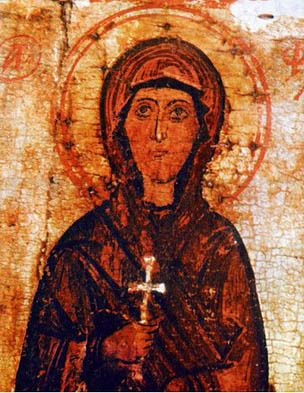
The Holy First-Martyress and Equal-to-the-Apostles Thekla was born in the city of Iconium. She was the daughter of rich and illustrious parents, and moreover she was distinguished by extraordinary beauty. At 18 years of age they betrothed her to an eminent youth. But having heard the preaching of the holy Apostle Paul about the Saviour, Saint Thekla with all her heart came to love the Lord Jesus Christ, and she steadfastly resolved not to enter into marriage, but rather to devote all her life to preaching the Gospel. The mother of Saint Thekla was opposed to her daughter's plans and demanded that she enter into marriage with the bridegroom betrothed to her. Saint Thekla's fiancee likewise made a complaint to the governor of the city against the Apostle Paul, accusing him of turning his bride against him. The governor locked up Saint Paul in prison. During the night Saint Thekla secretly ran away from her house, and she bribed the prison guards, giving them all her gold ornaments, and so made her way into the prison to the prisoner. For three days she sat at the feet of the Apostle Paul, hearkening to his fatherly precepts. The disappearance of Thekla was discovered, and servants were sent out everywhere in search of her. Finally they found her in the prison and brought her home by force.
At his trial the Apostle Paul was sentenced to banishment from the city. And with Saint Thekla they again began urging her to consent to the marriage, but she would not change her mind. Neither the tears of her mother, nor her wrath, nor the threats of the governor were able to separate Saint Thekla from her love for the Heavenly Bridegroom, the Lord Jesus Christ. Her mother in a insane rage demanded from the judges a death sentence against her unyielding daughter, and Saint Thekla was sentenced to burning. Without flinching, the holy martyress went into the bon-fire and made the sign of the cross over herself. At this moment the Saviour appeared to her, blessing her present deed, and inexpressible joy filled her holy soul. The flames of the bon-fire shot up high, but the martyress was surrounded by an halo and the flames did not touch her. Thunder boomed, and a strong downpour of rain with hail extinguished the bon-fire. The torturers scattered in fear. Saint Thekla, kept safe by the Lord, quit the city and with the help of a certain Christian youth searched out the Apostle Paul. The holy apostle and his companions, among which was also the Disciple Barnabas, were hidden away in a cave not far from the city, praying fervently, that the Lord would give strength to Saint Thekla in her sufferings. After this, Saint Thekla went together with them preaching the Gospel in Antioch. In this city she was pursued by a certain dignitary named Alexander, who was captivated by her beauty. Saint Thekla refused his offer to enter into marriage, and so for being a Christian she was condemned to death. Twice they set loose upon her hungry wild animals, but they would not touch the holy virgin, but instead lay down meekly and licking at her feet. The Providence of God preserved the holy martyress unharmed through all her torments. Finally, they tied her to two oxen and began to chase after her with red-hot rods, but the strong cords broke asunder like cob-webs, and the oxen ran off, leaving Saint Thekla unharmed. And the people began shouting: "Great is the God of the Christians!" The governor himself became terrified, reasoning it out finally, that the holy martyress was being kept safe by the Almighty God, Whom she served. He then gave orders to set free the servant of God Thekla. With the blessing of the Apostle Paul, Saint Thekla then settled in the desolate surroundings of Isaurian Seleucia and dwelt there for many years, constantly preaching the Word of God and healing the sick through her prayer. Saint Thekla converted many pagans to Christ, and the Church names her worthily as "Equal-to-the-Apostles" ("Ravnoapostol'na"). Even a pagan priest, seeking to assault her purity and punished for his impudence, was brought by her to holy Baptism. More than once the enemy of the race of man tried to destroy Saint Thekla through people blinded by sin, but the power of God always preserved this faithful servant of Christ. When Saint Thekla was already a 90 year old woman, pagan sorcerers became incensed at her for treating the sick for free. They were unable to comprehend that the saint was healing the sick by the power of the grace of Christ, and they presumed that the virgin-goddess Artemis (Diana) was her especial patroness. Out of envy against Saint Thekla, they sent their followers to defile her. When they had already approached quite close to her, Saint Thekla cried out for help to Christ the Savior, and the hill split open and hid the holy virgin, the bride of Christ. And thus did Saint Thekla offer up her holy soul to the Lord. Holy Church glorifies the "First-Suffering" Thekla as "of women the glory and guide for suffering, opening up the way through every torment". From of old many a temple was dedicated to her, one of which was built at Tsargrad (Constantinople) by the holy Equal-to-the-Apostles Constantine (Comm. 21 May). And then too, the name of the First-Martyress Equal-to-the-Apostles Thekla, a prayer intercessor for the ascetic, is remembered during the tonsure of women into monasticism.
ICON: “Mirozh" of the Mother of God
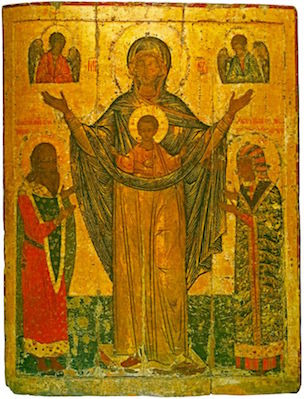
The Mirozh Icon appeared at the Mirozh monastery in the year 1198. But later, during the reign of Ivan the Terrible, at a time when a plague raged at Pskov, an ancient report tells how tears flowed from both eyes of the icon. Many benefits and healings for man occured from the icon of the Mother of God." The Mirozh Icon is an "Orans" ("Praying") type. On either side of the Most Holy Theotokos stand the Pskov Saints: on the right, the holy Prince Dovmont-Timothy (May 20); on the left, his wife, the holy nun Martha, in the world named Maria Dimitrievna (November 8, 1300). Tsar Ivan Vasilievich took away the wonderworking icon from Pskov, but at the monastery an exact copy remained: the so-called "Great Panagia" from the Savior-Mirozh monastery. On September 24, 1567, on the Feast of St Abraham at the Mirozh monastery there occurred a miraculous sign from an ancient icon of the Most Holy Theotokos. The celebration of the Mirozh Icon of the Sign was established in that same year, with the blessing of Archbishop Pimen of Novgorod and Pskov. A special service to this icon was composed, and was published in the 1666 MENAION.
All texts: © 1996-2001 by translator Fr. S. Janos.
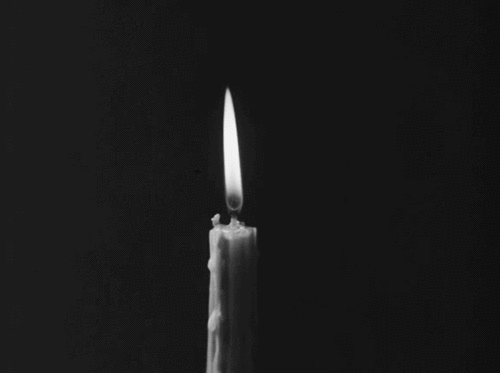
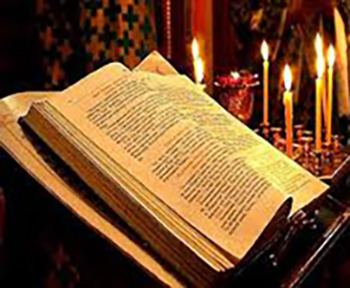
uke 4:1-15
1Then Jesus, being filled with the Holy Spirit, returned from the Jordan and was led by the Spirit into the wilderness, 2 being tempted for forty days by the devil. And in those days He ate nothing, and afterward, when they had ended, He was hungry. 3 And the devil said to Him, "If You are the Son of God, command this stone to become bread." 4 But Jesus answered him, saying, "It is written, 'Man shall not live by bread alone, but by every word of God.' " 5 Then the devil, taking Him up on a high mountain, showed Him all the kingdoms of the world in a moment of time. 6 And the devil said to Him, "All this authority I will give You, and their glory; forthis has been delivered to me, and I give it to whomever I wish. 7 Therefore, if You will worship before me, all will be Yours. 8 And Jesus answered and said to him, "Get behind Me, Satan! For it is written, 'You shall worship the LORD your God, and Him only you shall serve.' " 9 Then he brought Him to Jerusalem, set Him on the pinnacle of the temple, and said to Him, "If You are the Son of God, throw Yourself down from here. 10 For it is written:'He shall give His angels charge over you, To keep you,' 11 and, 'In their hands they shall bear you up, Lest you dash your foot against a stone.' " 12 And Jesus answered and said to him, "It has been said, 'You shall not tempt the LORD your God.' " 13 Now when the devil had ended every temptation, he departed from Him until an opportune time. 14 Then Jesus returned in the power of the Spirit to Galilee, and news of Him went out through all the surrounding region. 15 And He taught in their synagogues, being glorified by all.
4 notes
·
View notes
Text
Saints&Reading: Thu., Feb, 25, 2021
Commemorated on February 12_by the new calendar
Saint Meletios, Archbishop of Antioch (381)

Saint Meletios, Archbishop of Antioch, was at first a bishop of Sebasteia in Armenia (c.357), and afterwards he was summoned by the emperor Constantius to Antioch to help defend against the Arian heresy, and received there the cathedra-seat. Saint Meletios struggled quite zealously against the Arian error, but through the intrigues of the heretics he was thrice deposed from his cathedra-seat; Constantius had become surrounded by the Arians and had been swayed over to their position. In all this Saint Meletios was distinguished by an extraordinary gentleness, and he constantly led along his flock by the example of his own virtue and kindly disposition, presupposing that upon such like a soil sprouts more readily the seeds of the true teaching of the faith. Saint Meletios was the one who ordained as deacon the future hierarch Saint Basil the Great. And Saint Meletios also baptised and encouraged the growth under him of another of the greatest luminaries of Orthodoxy – Saint John Chrysostom, who afterwards wrote an eulogy to his former archpastor. After Constantius, the throne was occupied by Julian the Apostate, and the saint again was expelled, having to hide himself away in secret places for his safety. But again returning under the emperor Jovian in the year 363, Saint Meletios wrote his theological tract, "Exposition of the Faith", which facilitated the conversion to Orthodoxy of many of the Arians. In the year 381, under the emperor Theodosius the Great (379-395), the Second OEcumenical Council was convened. Already in the year 380 the saint had set off on his way to the Second OEcumenical Council at Constantinople, and came to preside over it. Before the start of the Council, Saint Meletios raised up his hand displaying three fingers, and then conjoining together two fingers and bending the one he blessed the people, proclaiming: "We apprehend three hypostatic-persons, and we speak about one self-same nature," – and with this declaration of the saint there flashed the fire of a lightning-bolt. During the time of the Council Saint Meletios expired to the Lord. Saint Gregory of Nyssa honoured the memory of the deceased with an eulogistic word. There are preserved discourses of Saint Meletios concerning the One-in-Essence nature of the Son of God with God the Father, and also his letter to the emperor Jovian about the confessing of the Holy Trinity. The relics of Saint Meletios were transferred from Constantinople to Antioch.
Saint Alexi, Metropolitan of Moscow and All Russia the Wonderworker

Saint Alexei, Metropolitan of Moscow and All Russia the Wonderworker, (in the world Elevtherii), was born in the year 1292 (or by another source 1304) at Moscow into the family of the boyar-noble Theodore (Feodor) Byakont, a descendant of the Chernigov princely line. The Lord early on revealed to the future saint his lofty destiny. At twelve years of age Elevtherii ha set a snare for the netting of birds, and imperceptibly he dozed off and suddenly he heard quite distinctly a voice: "Alexei! Why toilest thou in vain? Thou art to be a netter of people".From this day on the lad tended towards seclusion, he frequently visited church, and at age fifteen he decided to become a monk. In 1320 he entered the Moscow Theophany monastery, where he spent more than twelve years at strict monastic efforts. As guides for him and his companions there were the reknown ascetics of the monastery, the startsi-elders Gerontii and Stefan, brother of the Monk Sergei of Radonezh. Metropolitan Theognist then bade the future saint to leave the monastery and manage the juridical affairs of the Church. The saint fulfilled this office for 12 years as vicar of the metropolitan. Towards the end of 1350 Vladyka Theognist had Alexei ordained as bishop of Vladimir; upon the death of the metropolitan he became his successor in the year 1354. During this period the Russian Church was torn amidst great rifts and quarrels, in part because of the pretensions of the metropolitan of Lithuania and Volynia, Roman. In 1356, in order to put an end to the troubles and disturbances, the saint set off to Constantinople to the OEcumenical Patriarch. Patriarch Kallistos gave Saint Alexei the right to both be called and to consider himself Archbishop of Kiev and Great Russia with the title, "All-Venerable Metropolitan and Exarch". On the return journey during the time of a storm at sea the ship was in danger of shipwreck. Saint Alexei prayed and gave a vow to build a temple to the saint of that day, when the ship should come to shore. The storm subsided, and the ship arrived on 16 August. Moscow delightedly came out to meet the saint.
All texts© 1996-2001 by translator Fr. S. Janos.


1 John 1:8-2:6
8If we say that we have no sin, we deceive ourselves, and the truth is not in us.9 If we confess our sins, He is faithful and just to forgive us our sins and to cleanse us from all unrighteousness.10 If we say that we have not sinned, we make Him a liar, and His word is not in us.
1My little children, these things I write to you, so that you may not sin. And if anyone sins, we have an Advocate with the Father, Jesus Christ the righteous. 2 And He Himself is the propitiation for our sins, and not for ours only but also forthe whole world. 3 Now by this we know that we know Him, if we keep His commandments.4 He who says, "I know Him," and does not keep His commandments, is a liar, and the truth is not in him. 5 But whoever keeps His word, truly the love of God is perfected in him. By this we know that we are in Him. 6 He who says he abides in Him ought himself also to walk just as He walked.
Philippians 2:5-11
5 Let this mind be in you which was also in Christ Jesus, 6 who, being in the form of God, did not consider it robbery to be equal with God,7 but made Himself of no reputation, taking the form of a bondservant, and coming in the likeness of men. 8 And being found in appearance as a man, He humbled Himself and became obedient to the point of death, even the death of the cross. 9 Therefore God also has highly exalted Him and given Him the name which is above every name,10 that at the name of Jesus every knee should bow, of those in heaven, and of those on earth, and of those under the earth,11 and that every tongue should confess that Jesus Christ is Lord, to the glory of God the Father.
#ortohodxy#orthodox christianity#ancientchristianity#originofchristianity#spirituality#holyscriptures#gospel#sacredtexts#wisdom
1 note
·
View note
Text
Saints&Reading: Sun., Oct. 25, 2020
Commemorated on October 12_ Julian calendar
St Martin “ The Merciful” of Tours ( 397)
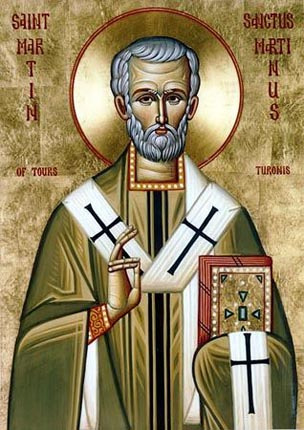
St. Martin of Tours, (born 316, Sabaria, Pannonia [now Szombathely, Hungary]—died November 8, 397, Candes, Gaul [France]; Western feast day, November 11; Eastern feast day November 12), patron saint of France, father of monasticism in Gaul, and the first great leader of Western monasticism.
Of pagan parentage, Martin chose Christianity at age 10. As a youth, he was forced into the Roman army, but later—according to his disciple and biographer Sulpicius Severus—he petitioned the Roman emperor Julian the Apostate to be released from the army because “I am Christ’s soldier: I am not allowed to fight.” When charged with cowardice, he is said to have offered to stand in front of the battle line armed only with the sign of the cross. He was imprisoned but was soon discharged.
While he was still in the military and a catechumen of the faith, Martin cut his cloak in half to share it with a beggar. That night, he dreamed that Jesus himself was clothed with the torn cloak. When he awoke, the garment was restored. Moved by this vision and apparent miracle, Martin immediately finished his religious instruction and was baptized at age 18.
On leaving the Roman army, Martin settled at Poitiers, under the guidance of Bishop Hilary. He became a missionary in the provinces of Pannonia and Illyricum (now in the Balkan Peninsula), where he opposed Arianism. Forced out of Illyricum by the Arians, Martin went to Italy, first to Milan and then to the island of Gallinaria, off Albenga. In 360 he rejoined Hilary at Poitiers. Martin then founded a community of hermits at Ligugé, the first monastery in Gaul. In 371 he was made bishop of Tours, and outside that city he founded another monastery, Marmoutier, to which he withdrew whenever possible.
As bishop, Martin made Marmoutier a great monastic complex to which European ascetics were attracted and from which apostles spread Christianity throughout Gaul. He himself was an active missionary in Touraine and in the country districts where Christianity was as yet barely known. In 384/385 he took part in a conflict at the imperial court in Trier, France, to which the Roman emperor Magnus Maximus had summoned Bishop Priscillian of Ávila, Spain, and his followers. Although Martin opposed Priscillianism, a heretical doctrine renouncing all pleasures, he protested to Maximus against the killing of heretics and against civil interference in ecclesiastical matters. Priscillian was nevertheless executed, and Martin’s continued involvement with the case caused him to fall into disfavour with the Spanish bishops. During his lifetime, Martin acquired a reputation as a miracle worker, and he was one of the first nonmartyrs to be publicly venerated as a saint.
Source: Britannica
The Transfer from Malta to Gatchina of a Part of the Wood of the Life-Creating Cross of the Lord, the Philermia Icon of the Mother of God and the Right Hand of Saint John the Baptist (1799)

The Transfer from Malta to Gatchina of a Part of the Wood of the Life-Creating Cross of the Lord, together with the Philermia Icon of the Mother of God and the Right Hand of Saint John the Baptist was done in the year 1799. These holy things were preserved on the island of Malta by the Knights of the Catholic Order of Saint John of Jerusalem. In 1798, when the French seized the island, the Maltese knights turned for defence and protection to Russia. On 12 October 1799 they offered these ancient holy things to the emperor Paul I, who at this time was situated at Gatchina. In the autumn of 1799 the holy items were transferred to Peterburg and placed in the Winter Palace within the church in honour of the Image of the Saviour Not-Made-by-Hand. The feast for this event was established in 1800.
Philermia Icon

By ancient tradition, the Philermia Icon of the Mother of God was written by the holy Evangelist Luke. From Jerusalem it was transferred to Constantinople, where it was situated in the Blakhernae church. In the XIII Century it was taken from there by crusaders and from that time kept by the Knights of the Order of Saint John.
The right Hand of John the Baptist

The Orthodox Church celebrates the Synaxis of John the Baptist and the translation of his right hand from Antioch to Constantinople. According to the Church’ tradition, John the Forerunner of our Lord, was buried in the city of Sebaste, Samaria. Saint Luke the Evangelist wanting to move St John’s whole body to Antioch, was able to obtain and translate only his right hand. Historians Theodoret and Rufinus mention that the tomb of St. John the Baptist was desecrated in 362, during the Emperor Julian the Apostate reign, and a part of St. John relics burned. What remained intact from Saint’ body was taken to Jerusalem, then to Alexandria, and on May 27, 395 was placed in the church that bears saint John’ name.
The chronicle of John Skylitzes (a Byzantine historian of the eleventh century) states that the right hand of St. John the Baptist was moved from Antioch to Constantinople in 956 by Emperor Constantine the VII or Porphyrogenites (913-959) to be placed in one of the chapels of the Grand Palais, that is in the church of the Most Holy Theotokos of Peribleptos. At the end of the twelve century, the Russian archbishop Anthony of Novgorod who went on a pilgrimage to Constantinople, mentions in his writings among other treasures of this church, the right hand of St. John the Baptist. According to Du Cange in 1263, Othon of Ciconia attested the presence of a small piece from St. John’ right hand, in Citeaux Abbey, France. In 1261, Othon aceepted the refuge of the Latin Emperor of Constantinople Baldwin the II and in exchange for a gift, the emperor gave Othon this piece of relic of St John. In a testimony of the Spanish ambassador Clavijo dated 1404, it is mentioned that the holy hand was still in the church of the Theotokos – Peribleptos in Constantinople. After the fall of Constantinople (in 1453), the hand of St. John the Baptist along with other Church’ treasures were seized by the Turks and kept in the imperial treasury. In some Turkish fiscal archives from 1484 kept in Topkapi, it is noted that Sultan Bayezid the II (1481-1512) sent the hand of St. John to Hospitallers from Rhodes, (who occupied this island during the first quarter of the fourteenth century), in order to earn their favor. Later, the Hospitallers took the relics to the island of Malta, where they established their quarter...continue reading
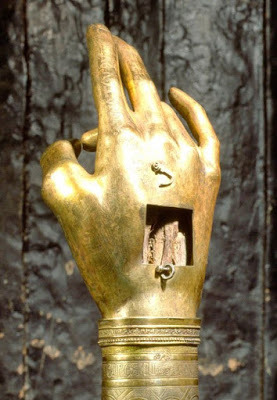


John 20:19-31
19Then, the same day at evening, being the first day of the week, when the doors were shut where the disciples were assembled, for fear of the Jews, Jesus came and stood in the midst, and said to them, "Peace be with you."20When He had said this, He showed them His hands and His side. Then the disciples were glad when they saw the Lord.21So Jesus said to them again, "Peace to you! As the Father has sent Me, I also send you."22 And when He had said this, He breathed on them, and said to them, "Receive the Holy Spirit. 23 If you forgive the sins of any, they are forgiven them; if you retain the sins of any, they are retained. 24 Now Thomas, called the Twin, one of the twelve, was not with them when Jesus came.25 The other disciples therefore said to him, "We have seen the Lord." So he said to them, "Unless I see in His hands the print of the nails, and put my finger into the print of the nails, and put my hand into His side, I will not believe." 26 And after eight days His disciples were again inside, and Thomas with them. Jesus came, the doors being shut, and stood in the midst, and said, "Peace to you!" 27 Then He said to Thomas, "Reach your finger here, and look at My hands; and reach your hand here, and put it into My side. Do not be unbelieving, but believing." 28 And Thomas answered and said to Him, "My Lord and my God!" 29 Jesus said to him, "Thomas, because you have seen Me, you have believed. Blessed are those who have not seen and yet have believed."30 And truly Jesus did many other signs in the presence of His disciples, which are not written in this book; 31 but these are written that you may believe that Jesus is the Christ, the Son of God, and that believing you may have life in His name.
Galatians 1:11-19
11But I make known to you, brethren, that the gospel which was preached by me is not according to man. 12 For I neither received it from man, nor was I taught it, but it came through the revelation of Jesus Christ.13 For you have heard of my former conduct in Judaism, how I persecuted the church of God beyond measure and tried to destroy it.14 And I advanced in Judaism beyond many of my contemporaries in my own nation, being more exceedingly zealous for the traditions of my fathers.15 But when it pleased God, who separated me from my mother's womb and called me through His grace, 16 to reveal His Son in me, that I might preach Him among the Gentiles, I did not immediately confer with flesh and blood, 17 nor did I go up to Jerusalem to those who were apostles before me; but I went to Arabia, and returned again to Damascus.18 Then after three years I went up to Jerusalem to see Peter, and remained with him fifteen days. 19 But I saw none of the other apostles except James, the Lord's brother.
#ortohodxy#ancientfaith#orthodoxchristianity#originofchristianity#holyscriptures#gospel#spirituality#sacredtexts#wisdom
3 notes
·
View notes
Text
Saints&Reading: Sat., Aug 15, 2020
Commemorated on August 2_Julian calendar
The Transfer from Jerusalem to Constantinople of the Relics of the Holy FirstMartyr (protomartyr) Stephen (428)
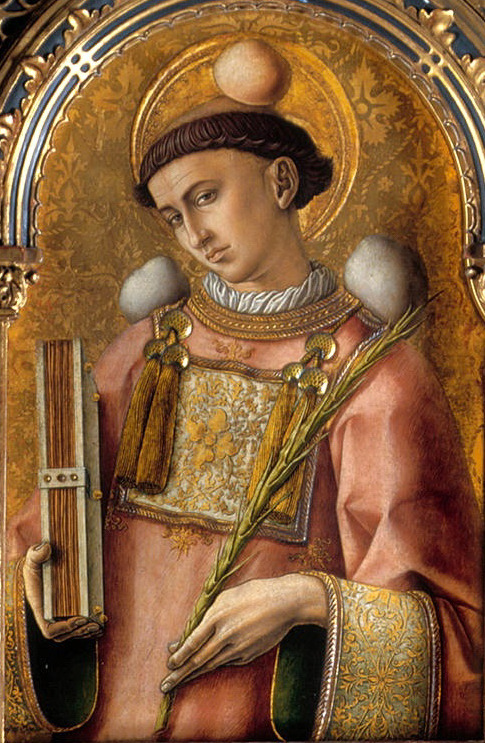
The Transfer from Jerusalem to Constantinople of the Relics of the Holy FirstMartyr Stephen occurred in about the year 428. After the holy FirstMartyr Archdeacon Stephen was pelted with stones by the Jews, they threw his holy body without burial for devouring by the beasts and birds. The reknown Jewish law-teacher Gamaliel, having begun to be inclined towards faith in Jesus Christ as the Messiah and also defending the Apostles at the Sanhedrin (Acts 5: 34-40), on the second night sent people devoted to him to take up the body of the Firstmartyr. Gamaliel gave him burial on his own grounds, in a cave, not far from Jerusalem. When in turn there died the secret disciple of the Lord, Nicodemus, who had come to Christ at night (Jn. 3: 1-21; 7: 50-52; 19: 38-42), Gamaliel likewise buried him nearby the grave of Archdeacon Stephen. Afterwards Gamaliel himself, having accepted holy Baptism together with his son Habib, was buried near the grave of the FirstMartyr Stephen and Saint Nicodemus. In the year 415 the relics of the saint were uncovered in a miraculous manner and solemnly transferred to Jerusalem by the archbishop John together with the bishops Eleutherios of Sebasteia and Eleutherios of Jericho. From that time began healings from the relics. Afterwards, during the reign of holy nobleborn emperor Theodosius the Younger (408-450), the relics of the holy FirstMartyr Stephen were transferred from Jerusalem to Constantinople and placed in a church in honour of the holy Deacon Laurentius, and after the construction of a temple in honour of the FirstMartyr Stephen the relics were transferred there on 2 August. The right hand of the FirstMartyr is preserved in the Serapionov chamber of the Troitsky-Sergiev Lavra.
© 1996-2001 by translator Fr. S. Janos.
Acts 6:8-15; 7:1-5, 47-60 (Protomartyr)
8 And Stephen, full of faith and power, did great wonders and signs among the people.
9 Then there arose some from what is called the Synagogue of the Freedmen (Cyrenians, Alexandrians, and those from Cilicia and Asia), disputing with Stephen.
10 And they were not able to resist the wisdom and the Spirit by which he spoke.
11 Then they secretly induced men to say, "We have heard him speak blasphemous words against Moses and God."
12 And they stirred up the people, the elders, and the scribes; and they came upon him, seized him, and brought him to the council.
13 They also set up false witnesses who said, "This man does not cease to speak blasphemous words against this holy place and the law;
14 for we have heard him say that this Jesus of Nazareth will destroy this place and change the customs which Moses delivered to us.
15 And all who sat in the council, looking steadfastly at him, saw his face as the face of an angel.
1 Then the high priest said, "Are these things so?"
2 And he said, "Brethren and fathers, listen: The God of glory appeared to our father Abraham when he was in Mesopotamia, before he dwelt in Haran,
3 and said to him, 'Get out of your country and from your relatives, and come to a land that I will show you.'
4 Then he came out of the land of the Chaldeans and dwelt in Haran. And from there, when his father was dead, He moved him to this land in which you now dwell.
5 And God gave him no inheritance in it, not even enough to set his foot on. But even when Abraham had no child, He promised to give it to him for a possession, and to his descendants after him.
47But Solomon built Him a house.
48 However, the Most High does not dwell in temples made with hands, as the prophet says:
49 Heaven is My throne, And earth is My footstool. What house will you build for Me? says the LORD, Or what is the place of My rest?
50Has My hand not made all these things?'
51You stiff-necked and uncircumcised in heart and ears! You always resist the Holy Spirit; as your fathers did, so do you.
52Which of the prophets did your fathers not persecute? And they killed those who foretold the coming of the Just One, of whom you now have become the betrayers and murderers,
53who have received the law by the direction of angels and have not kept it.
54When they heard these things they were cut to the heart, and they gnashed at him with their teeth.
55But he, being full of the Holy Spirit, gazed into heaven and saw the glory of God, and Jesus standing at the right hand of God,
56and said, "Look! I see the heavens opened and the Son of Man standing at the right hand of God!"
57Then they cried out with a loud voice, stopped their ears, and ran at him with one accord;
58and they cast him out of the city and stoned him. And the witnesses laid down their clothes at the feet of a young man named Saul.
59And they stoned Stephen as he was calling on God and saying, "Lord Jesus, receive my spirit."
60Then he knelt down and cried out with a loud voice, "Lord, do not charge them with this sin." And when he had said this, he fell asleep.
Matthew 17:24-18:4
24When they had come to Capernaum, those who received the temple tax came to Peter and said, "Does your Teacher not pay the temple tax?"
25He said, "Yes." And when he had come into the house, Jesus anticipated him, saying, "What do you think, Simon? From whom do the kings of the earth take customs or taxes, from their sons or from strangers?"
26Peter said to Him, "From strangers." Jesus said to him, "Then the sons are free.
27Nevertheless, lest we offend them, go to the sea, cast in a hook, and take the fish that comes up first. And when you have opened its mouth, you will find a piece of money; take that and give it to them for Me and you.
1At that time the disciples came to Jesus, saying, "Who then is greatest in the kingdom of heaven?"
2Then Jesus called a little child to Him, set him in the midst of them,
3and said, "Assuredly, I say to you, unless you are converted and become as little children, you will by no means enter the kingdom of heaven.
4Therefore whoever humbles himself as this little child is the greatest in the kingdom of heaven.
1 note
·
View note
Text
Icon, Saints&Reading: Wednesday, August 10, 2022
August 10_July 28
THE SMOLENSK ICON OF THE MOTHER OF GOD, NAMED "HODEGETRIA" (1046)

The Smolensk “Hodēgḗtria” Icon of the Theotokos, or “She who leads the way,” was, according to Church Tradition, painted by the holy Evangelist Luke during the earthly life of the Most Holy Theotokos. The holy hierarch Demetrius of Rostov suggests that this icon was painted at the request of Theophilus, the prefect of Antioch. From Antioch the holy image was transferred to Jerusalem. From there the empress Eudokia, the spouse of Arcadius, gave it at Constantinople to Pulcheria, the sister of the emperor, who put the holy icon in the Blachernae church.
In 1046, the Byzantine emperor Constantine IX Monomachos (1042-1054), gave his daughter Anna in marriage to Prince Vsevolod Yaroslavich, the son of Yaroslav the Wise. He blessed her on her way with this icon. After the death of Prince Vsevolod the icon went to his son Vladimir Monomachos, who transferred it at the beginning of the twelfth century into the Smolensk cathedral church in honor of the Dormition of the Most Holy Theotokos. From that time, the icon was known as the Smolensk Hodēgḗtria.
In the year 1238, at the bespeaking of the icon, the self-sacrificing Orthodox warrior Mercurius went by night into the camp of Batu and killed many of the enemy, in whose number was their most powerful warrior. Having accepted a martyr’s death in battle, he was included by the Church in the ranks of the Saints (November 24).
In the fourteenth century, Smolensk came into the possession of the Lithuanian princes. The daughter of prince Vitovt, Sophia, was given in marriage to the Moscow Great Prince Basil Dimitrievich (1398-1425). In 1398, she brought the Smolensk Icon of the Mother of God with her to Moscow. They set the holy image in the Annunciation cathedral of the Kremlin, on the right side of the Royal Doors.
In 1456, at the request of the inhabitants of Smolensk with Bishop Misael at the head, the icon was solemnly returned to Smolensk in a church procession, and at Moscow there remained two copies. One was put in the Annunciation cathedral, and the other, “a measure for measure,” was put in the Novodevichi monastery, founded in memory of the return of Smolensk to Russia. The monastery was built on Devichi Pole (Virgin’s Field), where “with many tears” the Muscovites handed over the holy icon to Smolensk. In 1602 an exact copy was painted from the wonderworking icon (in 1666 together with the ancient icon they brought a new copy to Moscow for restoration), which they placed in the tower of the Smolensk fortress wall over the Dneprovsk Gates, under a specially constructed cover. Afterwards, in 1727, a wooden church was built there, and in 1802, a stone church.
The new copy took on the power of the old image, and when the Russian armies left Smolensk on August 5, 1812, they took the icon with them for defense from the enemy forces. On the eve of the Battle of Borodino they carried this icon through the camp, to encourage and inspire the soldiers to great deeds. The ancient image of the Smolensk Hodēgḗtria, taken to the Dormition cathedral on the day of the Battle of Borodino went in procession with the Ivḗron and Vladimir Icons of the Mother of God through the Belo and Kitai quarters and the Kremlin walls, and then they sent it to the sick and wounded at the Lefortovo palace. After leaving Moscow, the icon was taken to Yaroslavl.
Thus were these sister-icons preserved, and the Mother of God defended Russia through Her icons. After the victory over the enemy forces the Hodēgḗtria Icon was returned to Smolensk together with its glorified copy.
The celebration in honor of this wonderworking icon on July 28 was established in the year 1525 in memory of the return of Smolensk to Russia.
There exist many venerated copies of the Smolensk Hodēgḗtria, for which the celebration is set on this day. There is also a day of celebration for the Smolensk Icon (November 5), glorified in the nineteenth century when this image was returned to Smolensk on the orders of the commander-in-chief of the Russian army M. I. Kutuzov. In memory of the expulsion of the enemy from Russia, it was decided to celebrate this day annually at Smolensk.
The holy icon of the Hodēgḗtria Mother of God is one of the chief holy objects of the Russian Church. Believers have received and do receive from it an abundant help of grace. The Mother of God through Her holy icon intercedes for and strengthens us, guiding us on the way to salvation, and we call out to Her, “Thou art the All-Blessed Hodēgḗtria for faithful peoples, Thou art the affirmation, the Praiseworthy of Smolensk and all the Russian land. Rejoice, Hodēgḗtria, salvation of Christians!”
THE HOLY DISCIPLES FROM THE 70: PROCHORUS, NIKANOR, TIMON AND PARMENAS (1st.c.)

Saints Prochorus, Nicanor, Timon and Parmenas, Apostles of the Seventy were among the first deacons in the Church of Christ.
In the Acts of the Holy Apostles (6:1-6) it is said that the twelve Apostles chose seven men: Stephen, Philip, Prochorus, Nicanor, Timon, Parmenas and Nicholas, full of the Holy Spirit and wisdom, and appointed them to serve as deacons.
They are commemorated together on July 28, although they died at various times and in various places.
At first, Saint Prochorus accompanied the holy Apostle Peter, who made him bishop in the city of Nicomedia. After the Dormition of the Most Holy Theotokos, Prochorus was a companion and coworker of the holy Apostle John the Theologian and was banished with him to the island of Patmos. There he wrote down the Book of Revelation concerning the final fate of the world. Upon returning to Nicomedia, Saint Prochorus converted pagans to Christ in the city of Antioch, where he suffered martyrdom.
Although Saint Nicanor suffered on the same day that the holy Protomartyr Stephen (December 27) and many other Christians were killed by stoning, he is also commemorated on December 28.
Saint Timon was later appointed by the Apostles as bishop of the city of Bostra in Arabia and suffered from the Jews and pagans for preaching the Gospel. He was thrown into a furnace, but by the power of God he came out of it unharmed. The tradition of the Roman Church says that Saint Timon died by crucifixion. Saint Timon is also commemorated on December 30.
Saint Parmenas zealously preached Christ in Macedonia. He died after being afflicted with an illness. Some say that Saint Parmenas suffered martyrdom under Trajan (98-117) in the final year of his reign.


LUKE 10:38-42; 11:27-28
38 Now it happened as they went that He entered a certain village; and a certain woman named Martha welcomed Him into her house. 39 And she had a sister called Mary, who also sat at Jesus' feet and heard His word. 40 But Martha was distracted with much serving, and she approached Him and said, "Lord, do You not care that my sister has left me to serve alone? Therefore tell her to help me." 41 And Jesus answered and said to her, "Martha, Martha, you are worried and troubled about many things. 42 But one thing is needed, and Mary has chosen that good part, which will not be taken away from her.
27 And it happened, as He spoke these things, that a certain woman from the crowd raised her voice and said to Him, "Blessed is the womb that bore You, and the breasts which nursed You!" 28 But He said, "More than that, blessed are those who hear the word of God and keep it!"
Father’s of the church commentaries
John Chrysostom AD 407: In this answer He sought not to disown His mother, but to show that His birth would have profited her nothing, had she not been really fruitful in works and faith. But if it profited Mary nothing that Christ derived His birth from her, without the inward virtue of her heart, much less will it avail us to have a virtuous father, brother, or son, while we ourselves are strangers to virtue.
Ephrem The Syrian AD 373: “Blessed is the womb that bore you.” He took blessedness from the one who bore him and gave it to those who were worshiping him. It was with Mary for a certain time, but it would be with those who worshiped him for eternity. “Blessed are those who hear the word of God and keep it.” Commentary on Tatian’s Diatessaron
PHILIPPIANS 2:5-11
Let this mind be in you which was also in Christ Jesus, 6 who, being in the form of God, did not consider it robbery to be equal with God, 7 but made Himself of no reputation, taking the form of a bondservant, and coming in the likeness of men. 8 And being found in appearance as a man, He humbled Himself and became obedient to the point of death, even the death of the cross. 9 Therefore God also has highly exalted Him and given Him the name which is above every name, 10 that at the name of Jesus every knee should bow, of those in heaven, and of those on earth, and of those under the earth, 11 and that every tongue should confess that Jesus Christ is Lord, to the glory of God the Father.
Clement Of Alexandria AD 215 God did all things through him. Therefore he is also said to have “taken the form of a slave.” It is not only the flesh of the slave that he assumed but the very nature of a slave that he assumed. He became a slave so that he could share human suffering in the flesh. –.
Cyril of AlexandriaAD 444 By this alone let the difference between the divinity and humanity in him be perceived. For Godhead and humanity are not the same in natural quality. Otherwise how has the Word, being God, been “emptied,” having let himself fall among lesser beings such as ourselves? But when we speculate on the mode of incarnation the human mind inevitably sees two things commingled by an inexpressible and unconfused union yet in no way divides the united elements but believes and firmly accepts that there is one from both, who is God, Son, Christ and Lord.
#ortohodxy#orthodoxchristianity#easternchristianity#originofchristianity#spirituality#holyscriptures#gospel#bible
1 note
·
View note
Text
Today’s Icon: The “Smolensk , Directress”
Commemorated on July 28_ Julian Calendar

The Smolensk Icon of the Mother of God, named "Hodegetria", which in Russian means "Putevoditel'nitsa" or "Way-Guide", was according to Church tradition written by the holy Evangelist Luke within the earthly lifetime of the MostHoly Mother of God. Sainted-hierarch Dimitrii of Rostov suggests that this image was written at the request of Theophilos, the governor of Antioch. From Antioch the holy image was transferred to Jerusalem. From there the empress Eudokia, the spouse of Arcadius, gave it at Constantinople to Pulcheria the sister of the emperor, who put the holy icon in the Blakhernai church. The Greek emperor Constantine IX Monomachos (1042-1054), – in 1046 having given his daughter Anna in marriage to prince Vsevolod Yaroslavich, the son of Yaroslav the Wise, – blessed her on her way with this icon. After the death of prince Vsevolod the icon went to his son Vladimir Monomakh, who transferred it at the beginning of the XII Century into the Smolensk cathedral church in honour of the Dormition (Uspenie) of the MostHoly Mother of God. From that time the icon received the title of Smolensk Hodegetria. In the year 1238 at the bespeaking of the icon, the self-sacrificing Orthodox warrior Merkurii by night penetrated into the camp of Batu and killed many of the enemy, in which number was also their most powerful warrior. Having accepted in the fight a martyr's end, he was enumerated by the Church to the ranks of the Saints (Comm. 24 November). In the XIV Century Smolensk came into the possession of the Lithuanian princes. The daughter of prince Vitovt, Sophia, was given for marriage to the Moscow GreatPrince Vasilii Dimitrievich (1398-1425). In 1398 she brought with herself to Moscow the Smolensk Icon of the Mother of God. They set the holy image in the Annunciation cathedral of the Kremlin, on the right side of the royal-doors. In 1456, at the request of the inhabitants of Smolensk with Bishop Misail at the head, the icon was solemnly in church procession returned to Smolensk, and at Moscow there remained two copies of it. One was put in the Annunciation cathedral, and the other – "a measure for measure" – was put in the Novodevichei monastery, founded in memory of the return of Smolensk to Russia. The monastery was built on Devichei Pole (Virgin's Field), where "with many tears" the Muscovites handed over the holy icon to Smolensk. In 1602 an exact copy was written from the wonderworking icon (in 1666 together with the ancient icon they conveyed a new copy to Moscow for restoration), which they situated in the tower of the Smolensk fortress wall over the Dneprovsk Gates, under a specially constructed mantle-cover. Afterwards, in 1727, was built there a wooden church, and in 1802 – a stone church. The new copy took on the power of grave of the old image, and when the Russian armies left Smolensk on 5 August 1812, they took the icon with them for defense from the enemy forces. On the eve of the Battle of Borodino they carried this image through the camp, to encourage and inspire the soldiers to the great deed. The ancient image of the Smolensk Hodegetria, taken for the while to the Uspensk cathedral, on the day of the Borodino battle was in procession around with the Iversk and Vladimir Icons of the Mother of God through the Belo and Kitai quarters and the Kremlin walls, and then they sent it to the sick and wounded at the Lefortovo palace. After the leaving of Moscow the icon was taken to Yaroslavl'. Thus of old were these sister-icons preserved, and the Mother of God through Her images defended the Native-land. After the victory over the enemy forces the Hodegetria Icon together with its glorified copy was returned to Smolensk. The celebration in honour of this wonderworking image on 28 July was establsihed in the year 1525 in memory of the return of Smolensk to Russia. There exist many venerated copies of the Smolensk Hodegetria, for which the celebration is set on this day. There is also a day of celebration for the Smolensk Icon, glorified in the XIX Century, – 5 November, when this image on the orders of the commander-in-chief of the Russian army M. I. Kutuzov was returned to Smolensk. In memory of the expelling of the enemy from the Fatherland, at Smolensk it was established to celebrate this day annually. The holy icon of the Hodegetria Mother of God – is one of the chief holy things of the Russian Church. Believers have received and do receive from it an abundant help of grace. The Mother of God through Her holy image intercedes for and strengthens us, guiding on the way to salvation, and we call out to Her: "Thou for faithful peoples – art the All-Blessed Hodegetria, Thou art the affirmation – the Praiseworthy of Smolensk and all the Russian land. Rejoice, Hodegetrix, salvation to Christians!"
© 1996-2001 by translator Fr. S. Janos.
1 note
·
View note